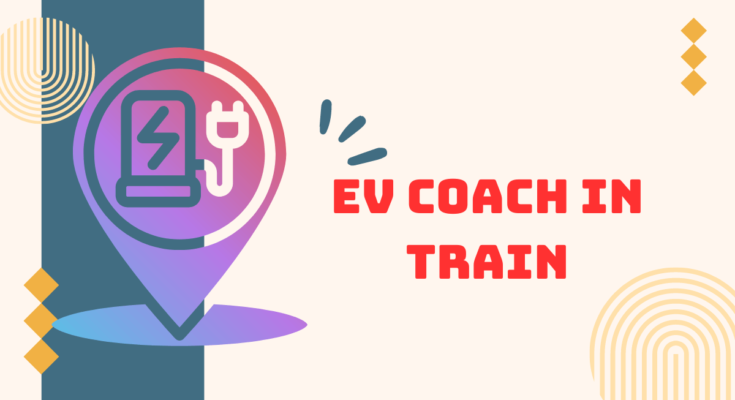EV Coach : full form of EV is Electric Vehicle
As of late, the transportation area has been seeing a critical shift towards manageability and development. One such development is the coordination of Electric Vehicle (EV) innovation into rail route frameworks, leading to the idea of EV mentors in trains. This article digs into the complexities of EV mentors, their innovation, advantages, challenges, and what’s in store possibilities they hold.
What is EV Coach?
An EV mentor is a rail line carriage or compartment that is controlled completely or somewhat by power. Dissimilar to conventional diesel-fueled mentors, EV mentors depend on electric drive frameworks, making them more energy-productive and harmless to the ecosystem.
How does EV Mentor Work?
EV mentors use different advances like batteries, electric engines, regenerative stopping mechanisms, and installed charging foundation. These parts cooperate to give the essential capacity to impetus, lighting, warming, and other locally available frameworks. Regenerative slowing down, for example, changes over active energy into electrical energy during deceleration, which is then put away in the locally available batteries for sometime in the future.
Advantages of EV Mentor in Trains:
Ecological Impact:
One of the essential benefits of EV mentors is their decreased natural impression contrasted with diesel-controlled partners. By dispensing with or limiting dependence on non-renewable energy sources, EV mentors add to bring down fossil fuel byproducts and air contamination, hence advancing cleaner and greener transportation.
Cost Efficiency:
Albeit the underlying interest in EV mentor foundation and innovation might be higher, the drawn out functional expenses are essentially lower. Electric impetus frameworks are more energy-effective and require less upkeep contrasted with diesel motors, bringing about cost reserve funds for rail route administrators and travelers the same.
Traveler Comfort:
EV mentors offer a calmer and smoother ride insight because of the shortfall of boisterous diesel motors. Moreover, electric warming and cooling frameworks give better environment control inside the mentors, improving traveler solace and fulfillment during their excursion.
Challenges and Limitations:
Framework Requirements:
One of the primary difficulties in executing EV mentors is the requirement for sufficient charging foundation along rail route courses. Assembling and keeping up with charging stations and above zap frameworks require significant speculation and coordination among partners.
Introductory Investment:
The forthright expense of progressing from regular to electric trains can be restrictive for some rail route administrators. Nonetheless, government impetuses, endowments, and headways in battery innovation are slowly making EV mentors all the more monetarily reasonable.
Innovative Limitations:
While EV innovation keeps on advancing quickly, certain restrictions actually exist, like reach tension and battery proficiency. Developments in battery innovation and charging foundation are important to address these difficulties and work on the presentation of EV mentors.
Future Outlook:
Regardless of the difficulties, the future standpoint for EV mentors in trains seems promising. With expanding accentuation on manageability and decarbonization in the transportation area, state run administrations and railroad administrators overall are effectively putting resources into charge projects. Proceeded with innovative work endeavors are supposed to drive further headways in EV innovation, making electric trains the standard as opposed to the exemption.
Conclusion:
All in all, EV mentors address a critical stage towards accomplishing cleaner, more effective, and economical rail line transportation. While difficulties, for example, framework prerequisites and mechanical restrictions persevere, the advantages of EV mentors concerning natural effect, cost productivity, and traveler solace offset the difficulties. With progressing speculations and headways in innovation, EV mentors are ready to assume a vital part in forming the fate of railroad transportation.
FAQs:
1. Are EV mentors totally emanation free?
– While EV mentors themselves produce no emanations during activity, the wellspring of power utilized for charging may affect by and large discharges.
2. What amount of time does it require to charge an EV coach?
– Charging times for EV mentors fluctuate contingent upon the charging framework and battery limit, yet quick charging advances are being created to lessen charging times fundamentally.
3. Can existing rail line tracks support EV coaches?
– Retrofitting existing tracks with jolt frameworks might be important to help EV mentors, however it requires cautious preparation and venture.
4. Are EV mentors more costly to produce than conventional coaches?
– At first, EV mentors might have a higher assembling cost because of the incorporation of electric impetus frameworks, however economies of scale and mechanical headways are driving costs down over the long haul.
5. What measures are being taken to work on the scope of EV coaches?*
– Examination into battery innovation, energy capacity frameworks, and regenerative slowing down are among the actions being taken to work on the reach and effectiveness of EV mentors.

